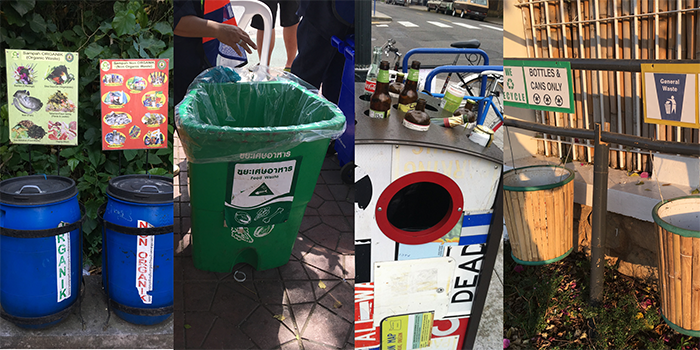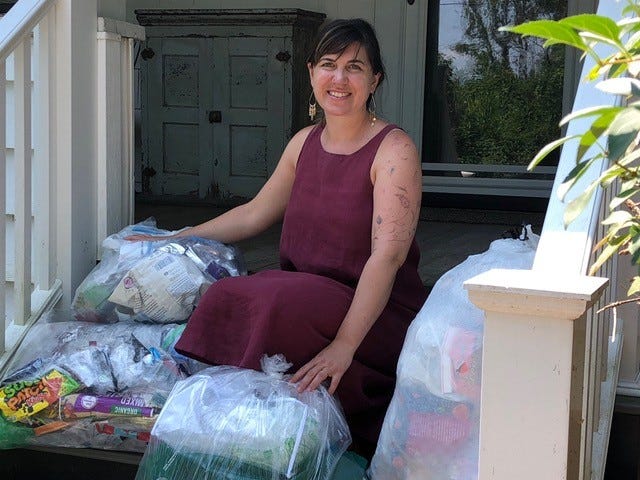The Trouble with Plastic and What We Can Do to Manage Our Waste

When I travel, I like to take pictures of innovative signage and recycling bins – I have a whole album devoted to it. No, seriously. Being involved in the waste industry consumes most of my waking life. I work for zero waste program TRUE, volunteer for waste and recycling advocacy groups, and spend a lot of my free time composting at community gardens or talking trash reduction strategies with friends.
Which is why I’ve spent the past year and a half or so concerned with the question of how the COVID-19 pandemic is going to impact the waste industry — especially plastics.
While my day job has me advocating for businesses to embrace zero-waste solutions, in my personal life I have challenged myself to be a “low to no waster” as much as possible. Being a professional in this industry has allowed me to be highly knowledgeable about recycling markets, trends, and packaging options. This plays a significant role in my decision to purchase or not purchase a product. I pay close attention to the recycling guidelines where I live and try my darndest not to wishcycle.

A few highlights from Celeste’s international recycling album.
I believe in recycling as a means to achieve a true circular economy, but I also know that reduction and reuse strategies are more effective. Being aware of my waste footprint is something I think about and strive to be better about, every single day, whether I’m at home or away.
The Trouble with Plastic Film
I’m into reducing my waste, and recycling what I can’t avoid. But there’s always been this one thing I haven’t been able to fully get away from: plastic film. Plastic film recycling is a whole topic in and of itself but the overview is that it can be recycled, but only with specific machinery which is typically not found in the average recycling center. It’s also everywhere and practically weightless, which is why it’s a common contaminant in the environment, especially in waterways. In fact, it is predicted that by 2050, there will be more plastic in the ocean than fish. To put this in perspective, only 70 years we have produced 8.3 billion tonnes of plastic, approximately 60% of which ends up in landfills or the environment.
I don’t like that plastic film is part of my life, and I try to avoid it as much as possible; but hey, film happens. However, I’m a member of the Park Slope Food Coop in Brooklyn, where I live. They have a Terracycle program to collect clean, sorted material. I’m a believer in Terracycle’s mission and their vision of a world where everything can be recycled and be made from recycled material. Luckily for me, the coop typically allows its members to drop off their plastic film from products purchased there.
But then the pandemic hit. I had been saving up my plastic film for a few months and was planning on taking it to the next drop off when the world turned upside down and the coop suspended their plastic film collection program. And here we are, 17 months into the pandemic plus about 2 months of saving, and we’re looking at all the plastic waste created by my family of 2 (plus dog) over a 17-month period. It’s all clean, and it’s all ready to be donated when the time comes.

Celeste McMickle’s 17 months of plastic are carefully sorted and ready to donate.
Recently, I’ve consumed more plastic than I would like, that’s for sure. I attribute this to a couple factors – one being the pandemic itself. Many products I used to buy in bulk are no longer available. But even with this amount of plastic, I still consider it a win. Plastic film is pretty much the only thing my household sends to landfill.
It’s also not lost on me that I was only able to save up the plastic film to be recycled later because I have the space to store it and have dedicated a generous amount of time and space to washing and drying this material. I recognize this presents its own question about the lifecycle of the materials vs. the amount of water used to clean it, and other arguments. However, based on my understanding of the circular economy, the ability for this material to stay out of the environment while also having a chance at another life means that I favor recycling. There are valuable end-markets for plastic film—it’s just hard to get that clean stream of good material.
How We Can Reduce Our Waste
As the saying goes, you can’t manage what you haven’t measured. If you aren’t aware of the waste you create, it’s hard to make a change. I recommend starting small. Track your waste over the period of a week, a month, or even a day. TRUE created a free, downloadable home waste audit to help you manage this process. You might be surprised by what you find yourself throwing away or incorrectly recycling, and you might be inspired with small changes that can be made to reduce certain types of wastes.
For instance, if there’s one change your household can make which has a big impact, it’s recycling food scraps. Food scraps are major emitter of methane and source of water pollution. In fact, 6%- 8% of climate change driving greenhouse gas emissions come from food waste. Find a local food scrap drop off in your area, a community garden that accepts material drop offs, or start composting in your backyard or countertop.
You and your family might not ever want to reach full “trash nerd” status like me, but in my experience, it’s a slippery slope. Once you start learning about the high-impact ways you can become a sustainable citizen, it’s easy to get hooked!
About the Author
You May Also Like


